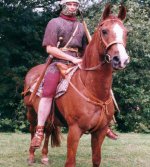♘امیرحسین♞
♘ مدیریت انجمن اسب ایران ♞
An equestrian (Latin eques, plural equites - also known as a vir egregius, lit. "excellent man" from the 2nd century AD onwards) was a member of one of the two upper social classes in the Roman Republic and early Roman Empire. This social class is often translated as "knight" or "chevalier" (French). However, this translation is not literal, since medieval knights relied on their martial skills, the physical power of their horse and armour to support their position, while the connection of Roman equestrians to horses had become more symbolic even in the early days of the Republic. The social position of medieval knights and Roman equestrians, however, was extremely alike, equestrians being the nearest Roman equivalent to Medieval nobility, the Roman tax farming system shared many similarities with medieval feudalism without actually being identical, due to inherent differences in the social structure and the level of central government.
The equites were the Roman middle class between the upper class of patricians and the lower class of plebs. The distinguishing mark of the equestrian class was a gold ring (that of the patrician was of iron) and narrow black band on the tunic.
Regnal origins
Regnal origins
Before the Middle Ages, most armies were largely composed of infantry. Horsemen were used as advance scouts, small fast raiding parties, troop escorts, and to outflank infantry lines. The majority of the fighting was done by infantry. Still, ancient armies needed cavalry, and the horsemen usually belonged to the highest classes, because no one else could afford a horse. Consequently, it was prestigious to own and ride a horse: one could show that one was rich and did not have to perform manual labor (or hand to hand combat).
Ancient Rome was no exception to this rule, although the horsemen received financial compensation to buy a horse (the equus publicus, horse bought by the commonwealth). Thus, originally, the equestrians were a military as well as a political group. It is said that king Servius Tullius divided the Roman nation into centuries, which were not only units of soldiers on the battlefield but also voting units in the so-called Centuriate Assembly. The Roman historian Livy offers a description of a complex system with 18 centuries of cavalry, 170 centuries of infantry, and 2 centuries of engineers. When the centuries came together to vote, the equites centuries cast their 18 votes first, followed by the 172 remaining centuries, and one additional vote for those who were too poor to serve in the army but still had a political vote. (Although the fact that the people were divided belongs to the age of kings, it is likely that these specific numbers date back to the fourth century BC.)
The equites were the Roman middle class between the upper class of patricians and the lower class of plebs. The distinguishing mark of the equestrian class was a gold ring (that of the patrician was of iron) and narrow black band on the tunic.
Regnal origins
Regnal origins
Before the Middle Ages, most armies were largely composed of infantry. Horsemen were used as advance scouts, small fast raiding parties, troop escorts, and to outflank infantry lines. The majority of the fighting was done by infantry. Still, ancient armies needed cavalry, and the horsemen usually belonged to the highest classes, because no one else could afford a horse. Consequently, it was prestigious to own and ride a horse: one could show that one was rich and did not have to perform manual labor (or hand to hand combat).
Ancient Rome was no exception to this rule, although the horsemen received financial compensation to buy a horse (the equus publicus, horse bought by the commonwealth). Thus, originally, the equestrians were a military as well as a political group. It is said that king Servius Tullius divided the Roman nation into centuries, which were not only units of soldiers on the battlefield but also voting units in the so-called Centuriate Assembly. The Roman historian Livy offers a description of a complex system with 18 centuries of cavalry, 170 centuries of infantry, and 2 centuries of engineers. When the centuries came together to vote, the equites centuries cast their 18 votes first, followed by the 172 remaining centuries, and one additional vote for those who were too poor to serve in the army but still had a political vote. (Although the fact that the people were divided belongs to the age of kings, it is likely that these specific numbers date back to the fourth century BC.)

